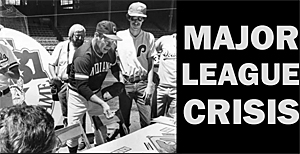


A Major League Crisis – and How a TV News Producer Attacked it with a Roll of the Dice
[by Howard Fencl, Hennes Communications]
Cleveland’s getting ready for another turn in the national spotlight with the 2019 Major League Baseball All-Star game. There’s a lot of revitalization to show off to national media doing sidebar travelogue pieces on the city.
Where else can you find a town celebrating its river’s miraculous recovery 50 years after industrial sludge ignited – an event that touched off a global environmental movement? Where else can you find I.M. Pei’s made-for-selfies Rock and Roll Hall of Fame? And we don’t care where LeBron is playing — he belongs to Cleveland and every person crammed into the Cavs NBA championship parade route a few years back will tell you the same thing.
So we’re ready for the media to descend. We’re ready for the crowds of tourists jamming sold-out downtown hotels. We’re ready – bring it!
Cleveland was ready to host the All-Star game in 1981 as well – with a whole lot less economic development to crow about, perhaps, but ready to show off the town on a national stage. Until crisis struck: A major league baseball players’ strike put the kibosh on Cleveland’s day in the sun. How would the city respond?
It didn’t. It took a young TV news producer with a wry sense of humor and a load of gumption to snatch shards of victory from the jaws of defeat and score national media coverage for the city on the very day the All-Star Game should have been played.
I was in my second year working in a TV newsroom at WKYC-TV, and my mentor, weekend evening producer Jon Halpern, a Strat-O-Matic baseball zealot, cooked up a plan to “play” the All-Star game in Cleveland Municipal Stadium – home of the Indians back then – with a board game and dice. It was a preposterous idea that he actually pulled off. And it was a ton of fun.
He convinced the powers-who-be to let him use the stadium and the scoreboard – for free. He convinced Rocco Scotti, an operatic fixture at Cleveland sports events, to sing the National Anthem. He couldn’t get the stadium organ player to accompany Rocco that day, but he got the next best thing if you’re a Clevelander – an accordion player. “This was the first All-Star Game that sounded like an Italian wedding,” wrote reporter Franz Lidz in Sports Illustrated. And perhaps the pièce de résistance – Halpern convinced baseball legend and Hall of Famer Bob Feller to throw out the first “pitch” (roll of the dice).
It was my day off from the newsroom, but there was no way I was going to miss this spectacle. I was one of maybe 40 or so newsroom staffers, family and friends who “jammed” the old 80,000-seat stadium. Of course, we all sat closely together so that in tight video cutaway shots, it looked there was a crowd.
The National League won the faux All-Star game that day, as they would about a month later in August when the MLB strike ended and the game was finally played for real. With a gaping news hole left by the ballplayer strike, networks such as CBS News and ABC Nightline covered the Strat-O-Matic game. The board the game was played on was actually displayed in Cooperstown for a time.
The city has had All-Star Games since – hometown hero Sandy Alomar’s game-winning home run in 1997 now is legend. And this year’s edition of the Midsummer Classic – as we guarantee more than one TV type will call it – will feature the celebrities, glitz and Twitter frenzy that accompanies all such events in 2019.
But it won’t have an accordion. It won’t have Bob Feller or Rocco Scotti. And it won’t have that quintessential Cleveland crisis management instinct: When you get handed a pile of you-know-what – blow it up with fireworks.